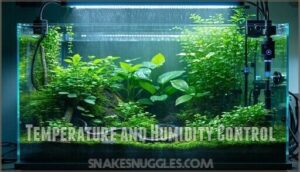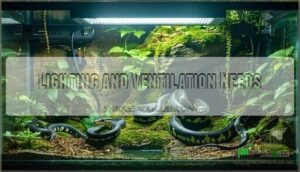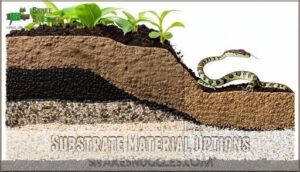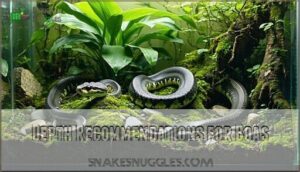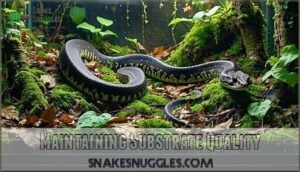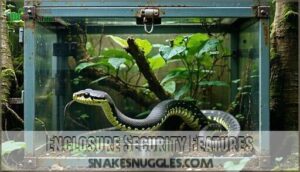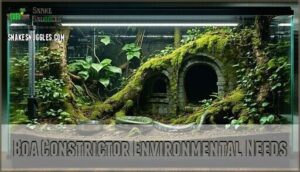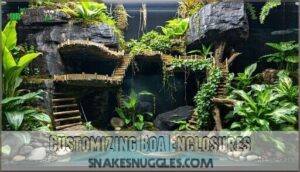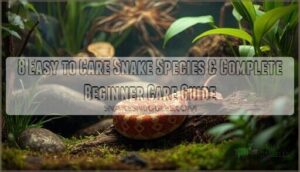This site is supported by our readers. We may earn a commission, at no cost to you, if you purchase through links.
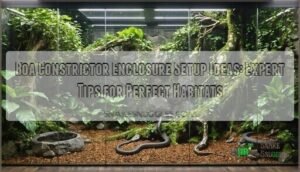 Your boa constrictor enclosure setup ideas should focus on creating a secure and comfortable habitat that mimics their natural environment.
Your boa constrictor enclosure setup ideas should focus on creating a secure and comfortable habitat that mimics their natural environment.
You’ll need a spacious enclosure with proper temperature gradients, hiding spots on both warm and cool sides, and adequate humidity levels between 50-60%.
Choose appropriate substrate like cypress mulch or paper towels for easy cleaning, and install secure locks since boas are escape artists who’ll test every weakness in your setup.
Add climbing branches for younger boas and make certain proper ventilation without creating drafts, as the right lighting cycle helps maintain their natural rhythms while UVB isn’t strictly necessary for most setups.
Table Of Contents
- Key Takeaways
- Boa Enclosure Basics
- Choosing Substrate Depth
- Enclosure Security Features
- Boa Constrictor Environmental Needs
- Customizing Boa Enclosures
- Frequently Asked Questions (FAQs)
- What do boa constrictors need in their enclosure?
- How to set up a boa enclosure?
- What is the best cage for a boa constrictor?
- How deep should the substrate be for a boa constrictor?
- What feeding schedule works best for adult boas?
- How often should I clean the enclosure completely?
- Can multiple boas share the same living space?
- What signs indicate my boa is stressed?
- How do I safely handle my boa constrictor?
- Conclusion
Key Takeaways
- You’ll need at least a 6’x3’x3′ enclosure for adult boas with secure locks, proper temperature gradients (75-80°F cool side, 86-90°F warm side), and 60-70% humidity levels to prevent escapes and health issues.
- Install multiple hiding spots on both warm and cool sides, along with sturdy climbing branches that can support your boa’s weight, since these features reduce stress and support natural behaviors.
- Choose substrate like cypress mulch or coconut fiber at 3-4 inches deep for adults to allow natural burrowing while maintaining proper moisture retention and easy cleaning.
- Maintain your enclosure with weekly spot-cleaning, monthly substrate mixing, and regular equipment checks to prevent mold growth, bacterial buildup, and equipment failures that could harm your snake, ensuring a safe environment with proper temperature gradients.
Boa Enclosure Basics
Setting up your boa’s home correctly from the start saves you headaches later and keeps your snake healthy.
You’ll need to focus on three main areas: giving your boa enough space to move and grow, controlling temperature and humidity levels, and providing proper lighting and air flow.
Space and Size Requirements
Getting your boa constrictor habitat dimensions right is vital for their wellbeing. Adult boas need minimum enclosure dimensions of 6’L x 3’W x 3’H, while baby boas can start in 4’L x 2’W x 2’H setups.
Your snake enclosure design should provide vertical space for climbing – at least half your boa’s length in height. For peak health, guarantee proper temperature regulation with heat lamps.
Remember, proper boa enclosure size prevents stress and supports natural behaviors in your snake habitat.
Temperature and Humidity Control
Temperature control creates the foundation for your boa’s health and well-being.
You’ll need precise heating methods and humidity monitoring to maintain proper conditions year-round.
Essential temperature and humidity management steps:
- Install dual thermostats – Use separate heating elements with thermostat calibration for accurate temperature gradient control
- Monitor microclimate creation – Place hygrometers at both warm and cool ends to track humidity control effectiveness
- Adjust seasonally – Make seasonal adjustments to mimic natural temperature cycles your boa would experience
- Check equipment regularly – Verify all heating methods and monitoring devices function properly to prevent dangerous fluctuations
Consider using a quality thermostat product for ideal regulation.
Lighting and Ventilation Needs
Your reptile terrarium needs proper lighting and ventilation to thrive.
UVB lighting isn’t necessary for boas, but basking lamps create essential heat gradients.
Nighttime heat sources maintain temperatures without disrupting sleep cycles.
Airflow methods prevent stagnant air while humidity control systems maintain ideal moisture levels.
Install ventilation screens on opposite sides for cross-ventilation.
This setup supports your boa’s respiratory health and prevents mold growth in the enclosure.
Maintaining essential humidity levels is also vital for respiratory health.
Choosing Substrate Depth
You’ll need to choose the right substrate depth to keep your boa healthy and comfortable in its home.
The depth you pick affects how well your snake can burrow, thermoregulate, and feel secure in its enclosure.
Substrate Material Options
Your substrate choice affects everything from substrate cost to cleaning ease. Smart reptile substrate selection balances moisture retention with boa burrowing needs while considering allergen concerns for your boa constrictor’s health.
Top substrate options for your snake enclosure ideas:
- Naturalistic soil mixes – Combine topsoil, ReptiSoil, and sand for authentic vivarium environments
- Cypress mulch – Excellent moisture retention and odor control for comfortable burrowing
- Coconut fiber products – Eco-friendly, low-dust options that support natural behaviors
- Paper substrates – Budget-friendly choice for quarantine or health monitoring situations
For adults, a substrate depth of at least 8 cm is recommended, while neonates need at least 2 inches, impacting the enclosure’s humidity levels.
Depth Recommendations for Boas
Most adult boa constrictors need three to four inches of substrate depth for proper burrowing behavior. Juvenile boas require only two to three inches since they’re smaller.
Arboreal boas need minimal depth – just one to two inches works fine.
Avoid substrate compaction by mixing materials. Deep substrate helps with shedding needs and creates natural terrarium design for your snake care routine.
Maintaining Substrate Quality
Keeping your bioactive boa enclosure’s substrate fresh requires regular attention to prevent problems before they start.
You’ll need to spot-clean waste immediately and monitor moisture levels to avoid mold growth.
Here’s your maintenance checklist:
- Waste Removal – Remove feces and urates within 24 hours to prevent bacterial growth
- Mold Prevention – Check for white fuzzy spots weekly and increase ventilation if found
- Substrate Mixing – Turn the top layer monthly to prevent compaction and improve airflow
- Pest Control – Watch for gnats or mites that thrive in overly wet conditions
For reptile enclosure maintenance, focus on moisture balance.
Your snake enclosure maintenance tips should include checking humidity levels with a reliable gauge.
Replace substrate sections that smell sour or look discolored.
Different reptile substrate options have varying lifespans, so cypress mulch might last longer than paper towels in your setup.
Enclosure Security Features
Your boa’s enclosure needs proper security features to keep your snake safe and prevent escapes.
You’ll want secure locks, adequate hiding spots, and sturdy climbing structures that can support your boa’s weight.
Locking Mechanisms and Escape Prevention
Your boa’s strength can push open weak doors like they’re made of cardboard.
Your boa’s muscles could turn flimsy latches into broken plastic in seconds.
Install secure latches and cable locks on your reptile terrarium setup. Add lid weight to prevent lifting.
Modified enclosures need ratcheting locks at mid-points to reduce glass flex.
Regular checks guarantee your large snake cage stays escape-proof and functional.
Hiding Places and Visual Barriers
Your boa needs multiple snake hiding spots throughout the enclosure.
Place secure hides on both warm and cool sides. Use naturalistic barriers like cork bark or artificial rocks for visual security.
Add enrichment hides at different heights. Create hiding variety with caves, logs, and dense plants.
To prevent escapes, always consider secure enclosure design. This naturalistic vivarium approach reduces stress and promotes natural behaviors in your reptile habitat design.
Climbing Structures and Support
You’ll want sturdy climbing branches that can handle your boa’s weight without bending or breaking.
Mount branches securely to enclosure walls using heavy-duty brackets. Choose different textures like natural wood and artificial vines for grip variety.
Position branches at various heights to create multiple climbing levels. Test all structural integrity before adding your snake to prevent dangerous falls in your tropical snake habitat setup.
Boa Constrictor Environmental Needs
Creating the right environment for your boa constrictor requires careful attention to three critical factors that directly impact their health and behavior.
You’ll need to establish proper temperature gradients, maintain specific humidity levels, and provide adequate water sources to replicate their natural habitat conditions, ensuring a healthy and thriving boa constrictor through proper environment.
Temperature Gradients and Heat Sources
Creating proper reptile temperature gradients requires strategic planning.
Your heat source should establish a 75-80°F cool side and 86-90°F warm side, with basking spots reaching 92-95°F.
Use overhead heat lamps for natural infrared radiation and install thermostat control to prevent dangerous spikes.
Proper boa substrates also play a role in maintaining temperature and humidity.
Monitor both ends with thermometers for accurate reptile temperature control.
Humidity Levels and Maintenance
Proper reptile humidity levels keep your boa healthy and comfortable.
Maintain 60-70% humidity using a reptile hygrometer for accurate humidity monitoring. Poor reptile enclosure maintenance leads to shedding issues and health problems.
- Misting frequency: Spray enclosure 2-3 times weekly, adjusting based on readings
- Monitor consistently: Check hygrometer daily to prevent dangerous humidity swings
- Prevent mold growth: Guarantee proper ventilation and remove wet substrate immediately
- Watch for problems: Low humidity causes stuck shed; high humidity creates respiratory issues
Water and Hydration Requirements
Fresh water transforms your boa’s health during shedding cycles.
Place a large water bowl covering one-third of the enclosure floor for proper Water Bowl Size. Monitor reptile humidity levels between 60-70% using digital gauges.
Mist substrate twice weekly, increasing Misting Frequency during shedding periods.
Watch for Dehydration Signs like wrinkled skin or stuck shed.
Customizing Boa Enclosures
Creating a personalized habitat goes beyond basic requirements and transforms your boa’s enclosure into an engaging home.
You’ll want to balance natural aesthetics with practical enrichment that stimulates your snake’s instincts while making maintenance manageable, which can include practical enrichment to ensure a healthy environment.
Decorating and Enrichment Ideas
Decorating your boa’s home goes beyond just making it look good. Smart enrichment keeps your snake mentally sharp and physically active. Think of it as creating a snake playground that challenges their natural instincts.
- Live Plants for Terrarium: Boston ferns and pothos provide natural humidity while creating hiding spots
- Snake Climbing Branches: Thick grapevine and Mopani wood support your boa’s weight safely
- Water Features: Large bowls or shallow streams encourage soaking and exploration
Add Safe Plants like spider plants for visual variety. Backgrounds with embedded planters maximize vertical space. Include a Digging Box filled with cypress mulch for burrowing species.
Reptile Decor Ideas like puzzle feeders challenge your snake’s problem-solving skills. This arboreal boa setup supports natural behaviors while keeping your pet engaged and healthy. Consider PVC enclosures for efficient heat retention.
Hiding Places and Shelter Options
Your boa needs multiple secure hides that fit their body size perfectly.
Choose smooth materials like plastic or ceramic that won’t harbor bacteria.
You’ll want at least two hiding spots – one on the warm side and one on the cool side of the enclosure.
Clean these reptile hiding spots weekly to prevent odor buildup.
Avoid rough textures that could injure your snake’s delicate skin during shedding periods.
Consider that you can find a quality snake hide to make certain your boa feels safe and secure with smooth materials and a quality hide.
Creating a Naturalistic Environment
Successfully achieving naturalistic environments often involves combining bioactive substrate with carefully selected live plants.
Layer cypress mulch or coconut fiber substrate at least four inches deep to support plant roots and beneficial microorganisms.
Choose hardy plants like pothos or snake plants that thrive in humid conditions.
Add natural decor such as cork bark and driftwood for climbing opportunities and hiding spots.
Frequently Asked Questions (FAQs)
What do boa constrictors need in their enclosure?
Like creating a cozy hotel room, you’ll need the right amenities for your scaly guest. Provide a 40-gallon tank, heating pad, water bowl, hiding spots, and climbing branches for comfort.
How to set up a boa enclosure?
You’ll need a large 4x2x2-foot terrarium with proper heating, lighting, and humidity controls.
Install secure substrates, hiding spots, water bowls, and climbing branches.
Maintain 78-88°F temperatures with proper ventilation.
What is the best cage for a boa constrictor?
Adult boas need at least 75 gallons, but larger enclosures work better.
You’ll want a 4x2x2 feet terrarium minimum.
Glass terrariums with front-opening doors offer the best visibility and access for your snake.
How deep should the substrate be for a boa constrictor?
You’ll want to provide 2-4 inches of substrate depth for your boa constrictor. This allows natural burrowing behavior while preventing impaction from overly deep substrate that could cause digestive issues.
What feeding schedule works best for adult boas?
Feeding your adult boa mirrors nature’s rhythm—patience rewarded with growth.
You’ll feed every two to three weeks, offering appropriately-sized prey.
Adult boas thrive on this schedule, maintaining healthy weight without overfeeding stress.
How often should I clean the enclosure completely?
You should deep-clean your boa’s enclosure every 4-6 weeks.
Spot-clean waste immediately and replace water weekly.
Full cleaning involves disinfecting all surfaces, replacing substrate, and sanitizing decorations to prevent bacteria buildup and ensure a clean environment, with a focus on deep-clean.
Can multiple boas share the same living space?
No, don’t house multiple boa constrictors together.
They’re solitary animals that can become stressed, territorial, or cannibalistic when cohabitated.
Each boa needs its own separate enclosure for ideal health and safety.
What signs indicate my boa is stressed?
You’ll notice stress signs like refusing food, excessive hiding, rapid breathing, or defensive posturing. Watch for unusual aggression, lethargy, or irregular shedding patterns that signal your boa needs environmental adjustments.
How do I safely handle my boa constrictor?
Move slowly and support your boa’s body with both hands. Let them explore at their own pace. Avoid handling during shedding or after feeding. Keep sessions brief initially.
Conclusion
Creating the perfect boa constrictor enclosure setup ideas will transform your snake’s life from ordinary to extraordinary.
Your attention to detail in temperature gradients, secure locks, proper substrate, and hiding spots determines your boa’s health and happiness.
Remember that these powerful constrictors need space to move and climb, and with proper planning, you’ll create a habitat that meets all your boa’s natural needs.
Regular maintenance keeps humidity levels stable, and is essential for preventing escapes, ensuring your boa’s health and happiness while keeping them safe.
- https://reptifiles.com/boa-constrictor-care/boa-constrictor-enclosure-size/
- https://www.reddit.com/r/boas/comments/1hhd8cz/diy_enclosure_ideas/
- https://www.thebiodude.com/blogs/snake-caresheets/boa-constrictor-care-guide-and-bioactive-terrarium-maintenance
- https://www.youtube.com/watch?v=utcngLFcqbI
- https://dubiaroaches.com/blogs/how-to-guides/how-to-set-up-a-boa-constrictor-terrarium


